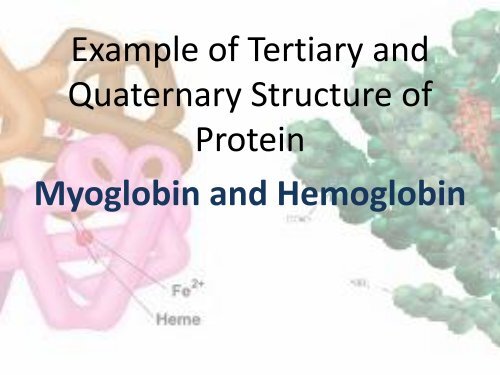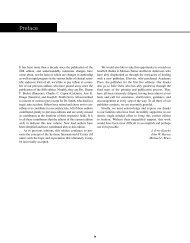Hemoglobin and Myoglobin - UMK CARNIVORES 3
Hemoglobin and Myoglobin - UMK CARNIVORES 3
Hemoglobin and Myoglobin - UMK CARNIVORES 3
Create successful ePaper yourself
Turn your PDF publications into a flip-book with our unique Google optimized e-Paper software.
Example of Tertiary <strong>and</strong><br />
Quaternary Structure of<br />
Protein<br />
<strong>Myoglobin</strong> <strong>and</strong> <strong>Hemoglobin</strong>
<strong>Myoglobin</strong><br />
• Was the first protein the complete<br />
tertiary structure was determined by<br />
X-tray crystallography<br />
• Has 8 α-helical region <strong>and</strong> no β-<br />
pleated<br />
• Hydrogen binding stabilize the α-<br />
helical region<br />
• Consist of a single polypeptide chain<br />
of 153 a.acid residue <strong>and</strong> includes<br />
prosthetic group- one heme group<br />
• Store oxygen as reserve against<br />
oxygen deprivation
• Example of quaternary structure of<br />
protein<br />
• Consist 4 polypeptide chain -4<br />
subunit- tetramer<br />
• Each subunit consist one heme group<br />
(the same found in myoglobin)<br />
• The chain interact with each other<br />
through noncovalent interaction –<br />
electrostatic interaction, hydrogen<br />
bonds, <strong>and</strong> hydrophobic interaction<br />
• any changes in structure of proteinwill<br />
cause drastic changes to its<br />
property<br />
• this condition is called allostery<br />
<strong>Hemoglobin</strong>
<strong>Hemoglobin</strong><br />
• An allosteric protein<br />
• Tetramer, 4 polypeptide chains (α2β2) -<br />
2α-chains <strong>and</strong> 2β-chains – nothing to do<br />
with αhelix <strong>and</strong> βsheet- its just a greek<br />
name<br />
• Bind O2 in lungs <strong>and</strong> transport it to cells<br />
• Transport C02 <strong>and</strong> H+ from tissue to lungs<br />
• The same heme group in mb <strong>and</strong> hb<br />
• Cyanide <strong>and</strong> carbon monoxide kill<br />
because they disrupt the physiologic<br />
function of hemoglobin<br />
• 2,3- biphosphoglycerate (BPG) promotes<br />
the efficient release of 02
Heme Group<br />
• Mb <strong>and</strong> Hb contain heme – a<br />
prosthetic group<br />
• Responsible to bind to 02<br />
• Consist of heterocyclic organic ring<br />
(porphyrin) <strong>and</strong> iron atom (Fe2+)<br />
• Oxidation of Fe 2t to Fe3+ destroy<br />
their biologic activity<br />
• Fe has 6 coordination sites that can<br />
form complexation bonds<br />
• Four are occupied by the N atoms<br />
• Free heme can bind CO 25,000 times<br />
than 02 – how Mb <strong>and</strong> Hb overcome<br />
this problem?
• The perfect orientation for CO<br />
binding is when all 3 atoms (Fe, C <strong>and</strong><br />
O) perpendicular to the to the plane<br />
of heme<br />
• Mb <strong>and</strong> Hb create hindered<br />
environment- do not allow O2 to bind<br />
at the required orientation- less<br />
affinity<br />
Structure of heme<br />
group in Mb <strong>and</strong> HB<br />
• The fifth coordination is occupied by<br />
Histidine residue F8<br />
• The O2 is bound at the 6 th<br />
coordination site of iron
heme group<br />
• The second histidine His E7<br />
– not bound to the heme,<br />
but acts a gate to open <strong>and</strong><br />
closes as oxygen enter the<br />
hydrophobic pocket<br />
• E7 inhibit O2 to bind to<br />
perpendicularly to heme<br />
• The presence of His E7 –<br />
will force CO to bind at the<br />
120 angle – make it lose it<br />
affinity to heme
Oxygen saturation in Mb <strong>and</strong> Hb<br />
• One molecule of Mb- can<br />
bind one molecule 02<br />
• HB (4 molecule)- can bind 4<br />
02<br />
• O2 bind to HB thru positive<br />
cooperativity – when one<br />
O2 is bound, it become<br />
easier for the next to bind<br />
• Dissociation of one O2 from<br />
oxygenated Hb will make<br />
the dissociation of 02 from<br />
other subunits easier
Different form of HB<br />
• Hb is bound to 02- oxyhemoglobin – relaxed<br />
(R state)<br />
• Without 02 – deoxyhb – tense (T) state<br />
• If Fe2+ is oxidized to Fe3+ - unable to bind 02-<br />
methemoglobin<br />
• C0 <strong>and</strong> NO have higher affinity for heme FE2+<br />
than 02- toxicity
Oxygen-saturation curve<br />
• <strong>Myoglobin</strong> is showing hyperbolic<br />
curve – easily saturated by<br />
increment of O2 pressure<br />
• Hb-sigmoidal curve – under the<br />
same pressure where Mb already<br />
near to saturation, Hb is still<br />
‘struggling’ to catch 02.<br />
• But, once one 02 bind to the<br />
molecule – more will bind to itcooperativity-<br />
increase in saturation<br />
• Same condition for dissociation of<br />
O2<br />
• Hb will release 02 easily in tissues<br />
compare to MB-thus make it a good<br />
02 transporter
Bohr Effect<br />
• Hb also transport CO2<br />
<strong>and</strong> H+ from tissues to<br />
lungs<br />
• When H+ <strong>and</strong> C02 bind<br />
to Hb- affect the affinity<br />
of Hb for oxygen – by<br />
altering the 3D structure<br />
• The effect of H+ - Bohr<br />
Effect<br />
• Not occur in Mb
Bohr effect<br />
• ↑[H+] – protonation of N terminal<br />
in Hb<br />
• Create a salt bridge<br />
• Low affinity of Hb to O2<br />
• Metabolically active tissues need<br />
more 02- they generate more C02<br />
<strong>and</strong> H+ which causes hemoglobin to<br />
release its 02<br />
• C02 produced in metabolism are in<br />
the form of H2CO3→ HCO3- <strong>and</strong> H+<br />
• HC03- is transported to lungs <strong>and</strong><br />
combined with H+→ C02 – exhaled<br />
• This process allow fine tuning Ph<br />
<strong>and</strong> level of C02 <strong>and</strong> 02
• An intermediate compound found<br />
in glucose metabolism pathway<br />
• Bind to T state of Hb to stabilize<br />
Hb <strong>and</strong> make it less affinity<br />
towards 02- will release 02 to cell<br />
• e:g: animal is quickly transported<br />
to mount side at altitude 4500m<br />
where the P02 is lower – delivery<br />
of 02 to tissue reduced<br />
• After few hours at high altitude-<br />
[BPG] in blood increase- decrease<br />
affinity of Hb to 02-delivery of O2<br />
to tissues is restored<br />
• The situation is reversed when<br />
the animal is returned to the sea<br />
level<br />
2,3 Biphosphoglycerate (BPG)
2,3 Biphosphoglycerate (BPG)<br />
• BPG also play role in<br />
supplying growing fetus<br />
with oxygen<br />
• Fetus must extract oxygen<br />
from its mother’s blood-<br />
Fetal Hb (HbF) must have<br />
higher affinity than the<br />
maternal Hb (HbA) for 02<br />
• HbF has α2γ2 subunit<br />
• This s/u has lower affinity<br />
towards BPG - higher<br />
affinity to O2 compare to<br />
HbA

















